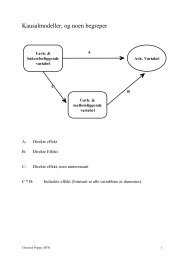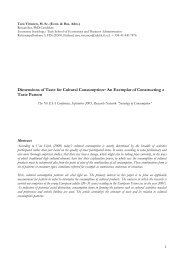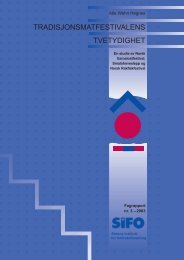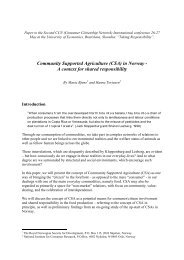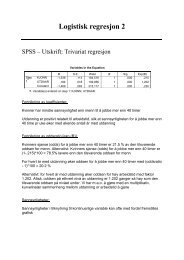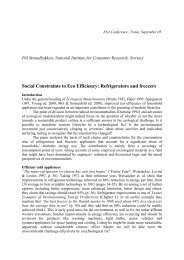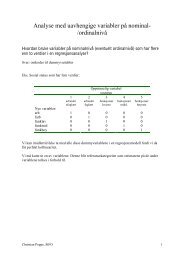an investigation of domestic laundry in europe - habits ... - SIFO
an investigation of domestic laundry in europe - habits ... - SIFO
an investigation of domestic laundry in europe - habits ... - SIFO
You also want an ePaper? Increase the reach of your titles
YUMPU automatically turns print PDFs into web optimized ePapers that Google loves.
Assessment <strong>of</strong> the consumer <strong>laundry</strong> <strong>habits</strong> - a qu<strong>an</strong>titative survey 43Greek respondents we found no variation with age, but on the whole, it is theGreek respondents who share this orientation most strongly. The signific<strong>an</strong>cemembers <strong>of</strong> the older generation put on cle<strong>an</strong>ness could be <strong>in</strong>terpreted as represent<strong>in</strong>gvalues <strong>an</strong>d traditions that have roots <strong>in</strong> a time when illnesses <strong>an</strong>drisks <strong>of</strong> <strong>in</strong>fection were a more relev<strong>an</strong>t hazard.Factor 3 designates <strong>an</strong> orientation towards <strong>laundry</strong> that it should be easy, i.e.not requir<strong>in</strong>g high temperatures, <strong>an</strong>d reveal<strong>in</strong>g quite a strong conviction thatmodern detergents c<strong>an</strong> do the job. Quite surpris<strong>in</strong>gly, it is the oldest generationwho score highest on this orientation, except among the Sp<strong>an</strong>ish respondentswho all have a strong op<strong>in</strong>ion that <strong>laundry</strong> should be easy (Factor 3).2.6.1 The oldest generation use their clothes the most times beforewash<strong>in</strong>g themThe overall pattern <strong>in</strong> the <strong>an</strong>alysis is that members <strong>of</strong> the oldest generation arethe ones who use their clothes the greatest number <strong>of</strong> times before wash<strong>in</strong>gthem. However, there are relatively small differences between the youngest<strong>an</strong>d the middle-aged respondents. (For further <strong>in</strong>formation see Brusdal2003)[32] This may suggest that <strong>in</strong> the future the young <strong>an</strong>d middle-aged consumers<strong>of</strong> today will cont<strong>in</strong>ue to wash clothes as <strong>of</strong>ten when they reach olderage as they do now.2.6.2 Different temperatures for different generationsDo wash<strong>in</strong>g temperatures differ accord<strong>in</strong>g to generation? Table 2-5 shows theme<strong>an</strong> temperatures that different generations use for different textiles. Ourpo<strong>in</strong>t <strong>of</strong> departure is the questions <strong>in</strong> the survey regard<strong>in</strong>g at what temperaturethe <strong>laundry</strong> was done. Cold water is given the value <strong>of</strong> 1 <strong>an</strong>d 90 °C the value<strong>of</strong> 6 (i.e. the higher the score, the warmer the water).With one exception, the table shows that it is the oldest generation who dotheir <strong>laundry</strong> <strong>in</strong> the warmest water. This is accord<strong>an</strong>ce with the same group’shigh score on factor 2, a factor stress<strong>in</strong>g the import<strong>an</strong>ce <strong>of</strong> cle<strong>an</strong>ness.Our next question is whether this differs between the different countries. Thisis a complex question; a few highlights will be presented here. In the Netherl<strong>an</strong>dsmembers <strong>of</strong> the oldest generation tend to do their <strong>laundry</strong> at the highesttemperatures. They are followed by the Norwegi<strong>an</strong> sample, which also re-




